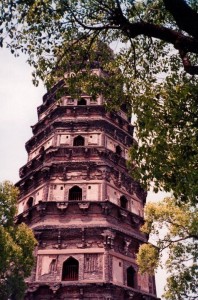 We visited Tiger Hill in Suzhou in April 1994. I took no notes about it, only a few pictures (to the right is the pagoda on the hill). But through the magic of the Internet — very low-grade magic, these days — I can pull up a description that’s a good stab at English by someone who’s first language is something else (some brand of Chinese, no doubt), but ultimately awkward.
We visited Tiger Hill in Suzhou in April 1994. I took no notes about it, only a few pictures (to the right is the pagoda on the hill). But through the magic of the Internet — very low-grade magic, these days — I can pull up a description that’s a good stab at English by someone who’s first language is something else (some brand of Chinese, no doubt), but ultimately awkward.
The writer’s also probably fond enough of Tiger Hill to write about it in Wiki for the English-speaking world see read about it.
All text is sic: “According to the Historical Records, the Wu King Helu was buried on the hill, called then ‘the Hill Emerging from the Sea’. The legend goes that three days after his burial a white tiger appeared squatting on the hill. Hence the name. It has an elevation of over 30 m. and covers about 49.41ac. Tiger Hill boasts impressive rocks, deep dales, 3 matchless scenes, 9 suitable occasions for enjoyment, 18 scenic spots, and changing scenery at all times. No wonder it has been an awe-inspiring sight in the area south of the Lower Yangtze.
“The Yunyan Temple Pagoda and the Sword Pool are well-known features of the hill. With a history going back more than 1,000 years, the simple, archaic and imposing Yunyan Temple Pagoda, also known as the Second Leaning Tower on earth, stands aloft at the top of the hill, serving as a symbol of ancient Suzhou for years.
“The Tomb of the Wu King Helu under the Sword Pool has remained an unsolved mystery for two and a half millennia. The story goes that the great Jin master Wang Xizhi traded his calligraphy for lovable geese from the Taoist Abbot. And the windy vale and cloudy spring make the visitor reluctant to leave.”